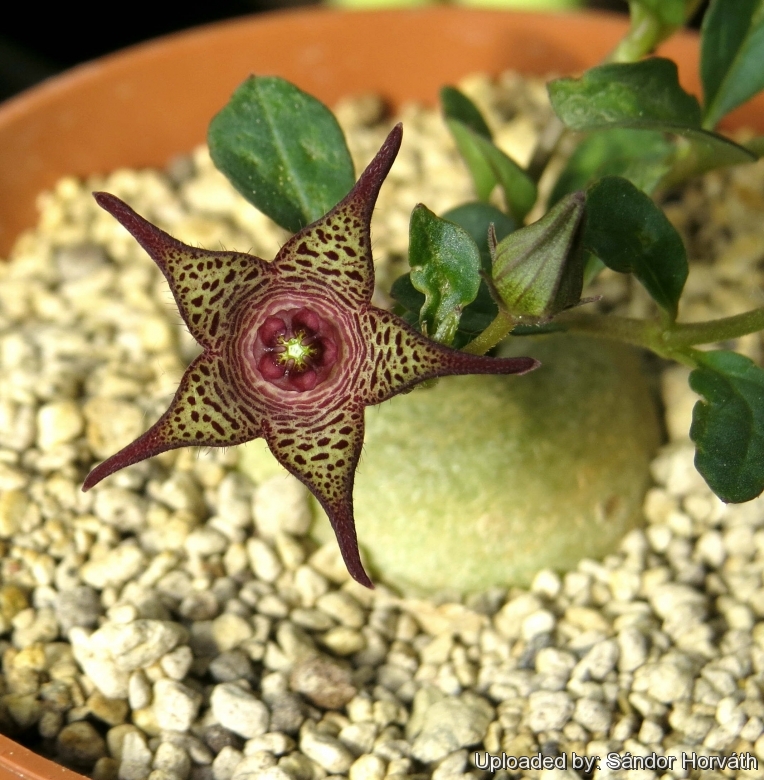
Brachystelma coddii Photo by: Sándor Horváth
Origin and Habitat: Brachystelma coddiiSN|32280]]SN|32280]] occurs in the north-eastern mountains of Swaziland extending into the eastern Transvaal mountains towards Pietersburg and southwards to at least as far as the district of Carolina.
Type: Swaziand, 3 miles upon Piggs Peak.
Habitat and ecology: In its typical form this species occurs on sandy outcrop, but may also hang from rock ledges.
Synonyms:
See all synonyms of Brachystelma coddii
Description: Brachystelma coddiiSN|32334]]SN|32280]] is a very leafy prostrate dwarf perennial herb with a small flattish tuber (caudex). Thin, reclining shoots emerge from the crown; they have short-petiolated, oval leaves up to 1.5 cm long. The small, basin-shaped flowers are about 20 mm in diameter, straw coloured, with red markings that extend to the base of the lobes.
Derivation of specific name: This species was named after the South African Botanist Codd Leslie Edward Wostall (1908-) director of the Botanical Research Institute, Pretoria, 1963-73.
Tuber (caudex): Roundish, only 20-50 mm diameter, 15-25 mm hight, somewhat depressed.
Annual stems: One to several, simple or branched from the base, rarely rebranched, prostrate, 5-15 (or more) cm long, with internodes 10-30 mm long, branches decumbent, 5-16 cm long, a little and fine hairy.
Leaves: Stalked short, arranged in an alternate or opposite position, ovoid to broad-ovoid, sometimes somewhat cordate 2.5 cm long, narrower and smaller as season progresses,
Flowers: Solitary, extra-axillary. Pedicels c. 10 mm long. Sepals linear-lanceolate, 3-4 mm long. Corolla 10 mm c. long, 17-20 mm in diameter, upper surface light green, with brown spots, but colouration is very variable. Tube shallowly saucer-shaped, about 7 mm across, c. 3 mm deep, parchment-coloured, with flesh-coloured markings extending to base of lobes. Lobes lanceolate, rarely triangular, 6-7 mm long, with margins somewhat recurved, velvety-maroon, or scartlet to yellowish red, usually becoming greenish yellow on tip. Corona about 2 mm high, shortly tubular at base, forming 5 pockets with outer margin V-shaped, confluent laterally and forming square shoulders to inner lobes; inner lobes oblong.
Blooming season: Flowering time is spring (October-December).
Similar species: Brachystelma coddiiSN|32324]]SN|32280]] is similar to Brachystelma pulchellumSN|32280]]SN|32324]], but much robust with larger flowers. It differs from its other close affinity, Brachystelma bruceaeSN|32280]]SN|32334]], in the saucer-shaped corolla containing the corona.
Bibliography: Major references and further lectures
1) J.P. Roux “Flora of Southern Africa” 2003
2) Raimondo, D., von Staden, L., Foden, W., Victor, J.E., Helme, N.A., Turner, R.C., Kamundi, D.A. and Manyama, P.A. 2009. "Red List of South African Plants." Strelitzia 25. South African National Biodiversity Institute, Pretoria.
3) Foden, W. & Potter, L. 2005. "Brachystelma coddii R.A.Dyer." National Assessment: Red List of South African Plants version 2015.1. Accessed on 2016/01/10
4) Mary Gunn, L. E. W. Codd “Botanical Exploration Southern Africa” CRC Press, 01 June 1981
5) David Hardy, Anita Fabian, Gerrit Germishuizen “Succulents of the Transvaal” Southern Book Publishers, 1992
6) Hermann Jacobsen “Abromeitiella to Euphorbia” Blandford Press, 1960
7) Hermann Jacobsen “A Handbook of Succulent Plants: Descriptions, Synonyms, and Cultural Details for Succulents Other Than Cactaceae”, Volume 1 Blandford Press, 1960
8) Werner Rauh “The Wonderful World of Succulents: Cultivation and Description of Selected Succulent Plants Other Than Cacti” Smithsonian Institution Press, 1984
Cultivation and Propagation: In cultivation the plants are usually grown in semi shade, with the tubers wholly or (preferably) partially exposed to prevent scorching and rotting of the roots. This plant can take a good deal of water during active growth and should be watered only when not dormant. Keep dryish in winter. It should be overwintered in the greenhouse at temperatures over 12°C (avoid letting temperatures drop lower than 5° C). Use a very draining but rich soil. An error in cultivation may produce unsightly holes in the tuber.
Reproduction: This species can be reproduced by seeds.











